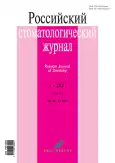Restoration of the contact surfaces and contact points of the posterior teeth from the practical dentists’ point of view: A questionnaire survey
- Authors: Nikolaev A.I.1, Shashmurina V.R.1, Ginali A.N.1, Permyakova A.V.1
-
Affiliations:
- Smolensk State Medical University
- Issue: Vol 25, No 5 (2021)
- Pages: 435-443
- Section: Organization of Healthcare Service
- Submitted: 04.07.2022
- Accepted: 04.07.2022
- Published: 15.09.2021
- URL: https://rjdentistry.com/1728-2802/article/view/109169
- DOI: https://doi.org/10.17816/1728-2802-2021-25-5-435-443
- ID: 109169
Cite item
Abstract
BACKGROUND: Increasing the efficiency of the restoration of the contact surfaces of the posterior teeth by considering age-related characteristics in performing direct aesthetic restoration with composite materials remains an urgent task of modern dentistry, requiring a comprehensive analysis of existing problems.
AIM: To assess the attitude of practitioners to the restoration of the contact points of the lateral teeth by direct composite restoration and the level of their practical and theoretical preparedness.
MATERIAL AND METHODS: A survey of 376 practical dentists conducting therapeutic reception of adult patients (“therapeutic dentistry” and “general dentistry”) was conducted: 238 dentists took part in the face-to-face survey and 138 dentists in the online survey.
RESULT: The restoration of the contact points during the treatment of patients with caries of the contact surfaces of the lateral teeth by direct composite restoration causes significant difficulties for practical dentists: 70.4±2.36% (p <0.005) of the respondents feel uncertain about the success of this manipulation, 14.4±1.77% regularly experience problems while performing this manipulation, 18.1±1.98% noted frequent or constant dissatisfaction with the results of their work after the restoration of the contact points of the posterior teeth, 76.2±2.19% (p <0.005) have information about age-related changes in the shape and topography of the contact points, 46.5±2.57% indicated the absence of methods and tools that allow to reproduce in clinical conditions the age-related features of the shape and topography of contact points, and 72.9±2.29% (p <0.005) prefer, if possible, not to take responsibility for the final outcomes of this manipulation.
CONCLUSION: Studies aimed at developing methods for restoring the age characteristics of contact points in treating patients with caries on the contact surfaces of the posterior teeth using aesthetic restoration with composite materials are necessary.
Full Text
About the authors
Aleksandr I. Nikolaev
Smolensk State Medical University
Author for correspondence.
Email: anicolaev@inbox.ru
ORCID iD: 0000-0002-1378-6538
MD, Dr. Sci. (Med.), professor
Russian Federation, 28, Krupskaya str, 214019, SmolenskViktoriya R. Shashmurina
Smolensk State Medical University
Email: anicolaev@inbox.ru
ORCID iD: 0000-0001-5216-7521
MD, Dr. Sci. (Med.), professor
Russian Federation, 28, Krupskaya str, 214019, SmolenskArseniy N. Ginali
Smolensk State Medical University
Email: anicolaev@inbox.ru
ORCID iD: 0000-0003-4467-3795
graduate student
Russian Federation, 28, Krupskaya str, 214019, SmolenskAnastasiya V. Permyakova
Smolensk State Medical University
Email: anicolaev@inbox.ru
ORCID iD: 0000-0003-4490-2041
assistant
Russian Federation, 28, Krupskaya str, 214019, SmolenskReferences
- Sarig R, Vardimon AD, Sussan C, et al. Pattern of maxillary and mandibular proximal enamel thickness at the contact area of the permanent dentition from first molar to first molar. American Journal of Orthodontics & Dentofacial Orthopedics. 2015;147(4):435–444. doi: 10.1016/j.ajodo.2014.11.026
- Nikolaev AI, Tsepov LM, editors. Practical therapeutic dentistry: textbook: in 3 vol. 10th edition, revised and enlarged. Moscow: MEDpress-inform; 2018. Vol. 1. (In Russ).
- Chuang SF, Su KC, Wang CH, Chang CH. Morphological analysis of proximal contacts in class II direct restorations with 3D image reconstruction. J Dent. 2011;39(6):448–456. doi: 10.1016/j.jdent.2011.04.001
- Loomans BA, Opdam NJ, Roeters FJ, et al. Restoration techniques and marginal overhang in Class II composite resin restorations. J Dent. 2009;37(9):712–717. doi: 10.1016/j.jdent.2009.05.025
- Wang Y, Song Y, Zhong Q, Xu C. Evaluation of influence factors on the width, length, and width to length ratio of the maxillary central incisor: A systematic review and meta-analysis. J Esthet Restor Dent. 2021;33(2):351–363. doi: 10.1111/jerd.12606
- Lyasova AO. Contact point restoration: the path to success. Bulletin of Medical Internet Conferences. 2017;7(10):1510–1516. (In Russ).
- Nikolaev AI, Tsepov LM, editors. Practical therapeutic dentistry: textbook: in 3 vol. 10th edition, revised and enlarged. Moscow: MEDpress-inform; 2021. Vol. 2. (In Russ).
- Sfondouris T, Prestipino V. Chairside management of an open proximal contact on an implant-supported ceramic crown using direct composite resin. J Prosthet Dent. 2019;122(1):1–4. doi: 10.1016/j.prosdent.2018.10.019
- Kolodkina VI, Arutyunov AV. Morphological structure of enamel, dentin of teeth and composite filling materials in vitro. Russian Journal of Dentistry. 2018;22(4):176–179. (In Russ).
- Lee SP, Lee SJ, Hayashi K, Park YS. A three-dimensional analysis of the perceived proportions of maxillary anterior teeth. Acta Odontol Scand. 2012;70(5):432–440. doi: 10.3109/00016357.2011.600716
- Maimulov VG, Luchkevich VS, Rumyantsev AP, Semenova VV. Fundamentals of scientific and literary work in medicine: scientific publication. 2nd ed., rev. and add. Saint Petersburg: Special. Lit.; 1996.
Supplementary files














